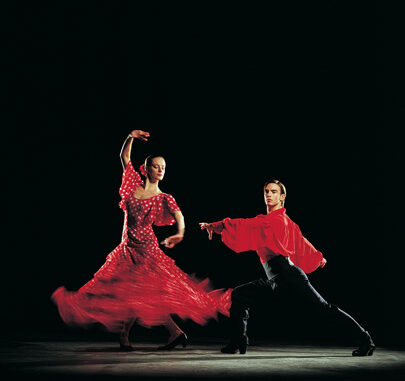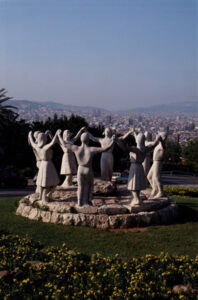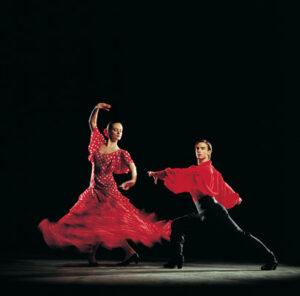

Neil Beer/Getty Images
This monument to the Catalán dance known as the sardana stands on the Montjuic hill in Barcelona.
The fiery flamenco and the symbolic sardana—both are traditional dances of Spain, but the similarity between the dances ends there. The essence and origins of the flamenco and sardana and the music that accompanies them could not be more different.
Take a look at the photograph of the monument to the sardana. Imagine these statues coming to life to the song of a cobla—a small band of various instruments and a tambourine. The circle of people joined together with their hands raised performs small, precise, perfectly timed steps of the sardana. More and more passersby of all ages and social classes spontaneously join in and the circle grows as the dance and the song of the cobla continues. The dance requires no costume and is not meant to be a performance. It is an opportunity for the people of Catalonia—Spain’s northeasternmost region, or comunidad autónoma, to connect with one another and their heritage. This is no mere folk dance; the sardana is the outward expression of the pride and unity felt by the Catalans. From the late 1940s to 1975, they saw their beloved Catalán language and traditions threatened by the powerful dictator Francisco Franco. In an effort to promote uniformity in Spain, Franco imposed strict laws forbidding the use of regional languages. Rebelling against Franco’s desire to “homogenize” Spain and remove their pride in their region’s unique heritage, the Catalans held tightly to the sardana. Through the three decades of Franco’s regime, the sardana became an even greater demonstration of the Catalans’ solidarity and a symbol of their identity. The sardana remains as the national dance of Catalonia and is enjoyed by proud Catalans (and onlookers!) every Sunday in Barcelona, as well as at various festivals and celebrations of the region.
While the present-day form of the sardana was evolving between the sixteenth and nineteenth centuries in Catalonia, the flamenco had already been practiced and performed since the fifteenth century in Andalucía, a comunidad autónoma in the south of Spain. Flamenco music and dancing were born from the merging of Jewish, Moorish, and Roma, or gitano, cultures. These groups of people all found themselves in Andalucía during the Spanish Inquisition. Like the Catalans holding on to their sardana, many Jews, Moors, and gitanos fled to the mountainous areas of Andalucía when the Catholic monarchs ordered them to abandon their traditions and convert to Christianity. The flamenco continued to evolve over the centuries, and by the 1700s it had came into its own. It flourished from 1842 to 1925, also known as the Golden Age of the Flamenco, in the cafes cantantes. Although it had established its current form by this time, the flamenco continues to evolve today.

Chris Nash/Getty Images
Flamenco dancers dress in elegant costumes.
The guitar music and singing, or toque and cante, of flamenco music, together with the dignified staccato foot stomping and hand clapping, graceful arm and hand movements, and turns and twirls of the flamenco dance, or baile, provoke deep emotion and are anchored at the forefront of Spain’s musical and dance heritage.
Explore More:
1. Explore videos of the sardana and flamenco on the Internet. Then compare the two dances using this chart. You may wish to include information from the eScape article. Present your comparison to your Spanish class (in Spanish, if possible). It might be helpful to create a PowerPoint® of photos of the two dances as a visual support for your presentation. If you have a blog, or if your class has one, you could post your presentation there.
2. Many Spanish descriptions of flamenco include the word Investigate some Spanish-language resources to learn what this word means (you may be surprised!) and how it applies to flamenco music and dancing. Share the information with your class.
Share What You Know:
1. Do you like to dance? Have you ever taken a dance class? Would you like to try to dance the sardana or the flamenco? Which dance is more appealing to you? Why? If you enjoy dancing, learn either the sardana or the flamenco and teach your classmates some of the basics.
2. The article mentions Francisco Franco’s regime and the Spanish Inquisition. Have you learned about these time periods in a history class? What do you remember about them? It might be interesting to refresh your memory by doing some research using Spanish-language resources. Take notes on the information you find. Then work with a partner or a group to discuss in Spanish all that you can about these historical eras. Talk about how the different ethnic groups may have felt during these periods.